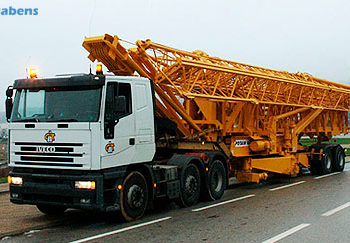
Law restricts circulation of large trucks in federal roads.
Starting today, long vehicles can not circulate on specific dates.
February 23rd, 2011.
Ordinance # 1 by the General Operations Coordination of the Federal Highway Police (PRF, acronym in Portuguese) was signed on January 20th, 2011; however, only from the date it is published on the Federal Daily Gazette – this Wednesday, 02/23 – and until January 1st, 2012, the circulation of long vehicles on federal single-lane roads will be considered a serious violation, and drivers may be fined 120 UFIRS (R$ 127.69), in specific periods, during some national holidays and days regarded by the Federal Government as “optional holidays.”
According with the ordinance, the following are regarded as long vehicles and subject to being penalized, even if bearing Special Traffic Authorization (AET, acronym in Portuguese): Cargo Vehicles Combinations – CVC (trucks that pull 2 or more units); Vehicle Transportation Combinations – CTV (car carriers); and Palletized Cargo and Vehicle Transportation Combinations – CTVP (special vehicles that carry very large-sized cargo, such as tractors, hoists, and cranes).
In the Ordinance, the PRF justifies the new restriction by means of the verified increase in vehicle traffic, with the resulting increase in the risk of accidents during holiday periods. Unfortunately, however, the government does not have the same concern when it comes to improving and preserving the national road system and the country’s transportation infrastructure – land, water, and air. Such an attitude would certainly result in a significant decrease in the amount of accidents.
In spite of mentioning “in national holiday periods,” the Ordinance does not set the restriction for all holidays. And, at the same time, without expressly mentioning it, it also restricts the movement of vehicles on days that are “optional holidays.” The ATTACHMENT referred to in the ordinance sets forth specific dates and times for the restriction, as reproduced below.
FEDERAL HIGHWAY POLICE DEPARTMENT General Operations Coordination Ordinance # 1 – January 20th, 2011
| FEDERAL HIGHWAY POLICE DEPARTAMENT General Operations Coordination Ordinance # 1 – January 20th, 2011 | |||
| ANEXO | |||
| OPERATION | SEASON | RESTRICTED | HOURS |
| CARNAVAL | 04/03/11 to 09/03/11 | 04/03 (friday) | 16H às 22H |
| 05/03 (saturday) | 6H às 12H | ||
| 08/03 (tuesday) | 16H às 22H | ||
| 09/03 (wednesday) | 6H às 12H | ||
| SEMANA SANTA | 20/04/11 to 24/04/11 | 22/04 (friday) | 6H às 12H |
| 24/04 (sunday) | 16H às 22H | ||
| CORPUS CHRISTI | 22/06/11 to 26/06/11 | 23/06 (thursday) | 6H às 12H |
| 26/06 (sunday) | 16H às 22H | ||
| PROCLAMAÇÃO DA REPÚBLICA | 11/11/11 to 15/11/11 | 12/11 (saturday) | 6H às 12H |
| 15/11 (tuesday) | 16H às 22H | ||
| FIM DE ANO | 16/12/11 to 01/01/12 | 23/12 (friday) | 6H às 12H |
| 25/12 (sunday) | 16H às 22H | ||
| 30/12 (friday) | 6H às 12H | ||
| 01/01/2012 (sunday) | 16H às 22H |
The Ordinance set only the aforementioned dates as restriction periods; however, some media companies have broadcast that circulation will be prohibited on all national holidays. Ultimately, the lack of accurate information may generate unjustified penalties which may be appealed. And the text of the new rule also offers the opportunity to “adjust the traffic of vehicles,” set by regional authorities, by means of an informed decision, due to the peculiarities of his/her location and traffic conditions.
In addition to knowing the dates expressly mentioned in the original text, it is convenient to remember that, for 2011, the Federal Government set forth the following national holidays: January 1st – New Year; April 21st – Tiradentes; May 1st – Labor Day; September 7th – Brazilian Independence Day; October 12th – Nossa Senhora Aparecida Day; November 2nd – All Soul’s Day; November 15th – Proclamation of the Republic; and December 25th – Christmas. And the following optional holidays: March 7th, 8th, and 9th – Carnival; April 22nd – Passion; June 23rd – Corpus Christi; and October 28th – Public Employee Day.
Unfortunately, PRF’s decision may also be reproduced by those responsible for state roads, an attitude which is already being evaluated in some states in the country’s Southeast and South regions.
Read more news from Locabens.










